Comprehensive Guide to Large Parrot Cages
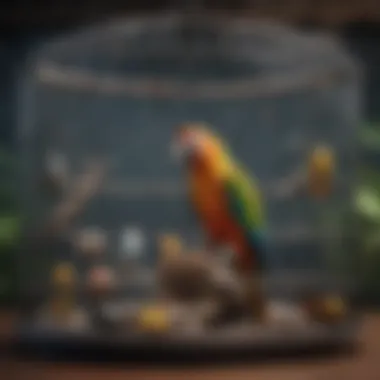
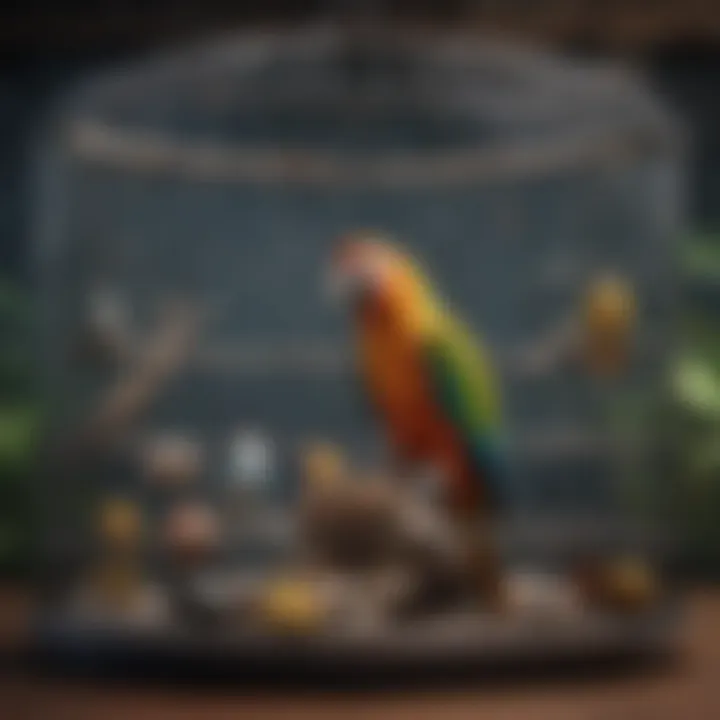
Intro
Large parrot cages are not merely enclosures; they significantly influence the health and happiness of our feathered companions. As bird owners, understanding the critical elements that contribute to an ideal cage setup is paramount. This guide aims to explore a range of considerations, from the types of cages available to the materials used in their construction. By prioritizing our birds' needs, we can create environments that promote both their physical well-being and behavioral health.
In the sections that follow, each aspect will be analyzed in detail. Care tips will offer insights into daily routines and maintenance tasks essential for keeping a clean and safe habitat. Behavioral insights will help owners interpret their pets' actions, emphasizing the importance of social interaction. Nutritional guides will clarify the dietary requirements necessary for various parrot species. Additionally, wellness and health will cover routine medical care and mental health considerations. Finally, enriching activities will present creative ways to engage birds and enhance their quality of life.
This comprehensive guide serves as an essential resource for pet bird owners and aspiring bird parents alike. The content herein will provide a well-rounded perspective on creating an optimal living space for parrots, covering everything from the foundational aspects of choosing and maintaining a cage to understanding the emotional and social well-being of these intelligent animals.
Understanding the Benefits of Large Parrot Cages
The significance of large parrot cages is critical for those who own or plan to acquire these intelligent and social birds. For pet bird owners, the choice of cage not only determines the comfort of their feathered companions but also directly influences their overall welfare. Investing in a spacious cage allows birds to express their natural behaviors, stay physically active and ultimately leads to long-term health and well-being.
Enhancing Bird Welfare
Providing a large cage enhances bird welfare in various ways. To start, larger spaces reduce the feeling of confinement, allowing parrots to move freely. Parrots are naturally curious creatures who explore their surroundings. A spacious cage caters to this instinct and reduces stress and anxiety that may arise from limited living conditions. Furthermore, proper ventilation is more achievable in larger cages, which promotes a healthier environment by reducing the buildup of ammonia and other potentially harmful substances.
Facilitating Natural Behaviors
Natural behaviors include flying, climbing, and playing. Large parrot cages foster these activities. Parrots require opportunities to stretch their wings and engage with their environment. A bigger cage with various perches and toys encourages play and exploration, which are essential for mental stimulation. When birds engage in such behaviors, they are less likely to develop behavioral issues, such as feather plucking or aggression. Setting up a cage that allows for multiple activities can mimic their natural habitat and promote psychological well-being.
Promoting Physical Health
The physical health of parrots is affected by their living conditions. Larger cages provide the space required for exercise, which is vital for maintaining a healthy weight and preventing obesity. When birds are active, they strengthen their muscles and cardiovascular systems, reducing the risk of health problems such as heart disease. Additionally, bigger cages allow for proper enrichment, which can include climbing structures and varied perches. All of these factors combined build a living space that significantly contributes to the longevity and vitality of the bird.
"A spacious, enriched environment is key to ensuring the well-being of pet birds."
Ultimately, the benefits of large parrot cages are substantial and multifaceted. Bird owners must consider the impact that cage size has on their pet's quality of life. A cage that meets these requirements is not merely a container; it is an essential part of a parrot's habitat that influences its behavior, health, and happiness.
Types of Large Parrot Cages
Understanding the different types of large parrot cages is crucial for providing the best possible environment for pet birds. Each type of cage serves unique purposes, catering to the needs of various species and allowing for different housing arrangements. The choice of cage often impacts the bird's behavior, mental stimulation, and overall welfare. Selecting the appropriate cage can enhance the experience for both the bird and the owner while minimizing stress for the pet.
Walk-In Cages
Walk-in cages represent one of the most spacious options available for parrot owners. These cages typically feature ample height and width to allow for easy human entry. They are ideal for those who want a large, safe space for their birds to roam. Birds kept in walk-in cages often display more natural behaviors, as the space encourages flying and exploration. This setup is particularly beneficial for larger species, such as macaws, which require more room due to their size.
Considerations for walk-in cages include the materials used, especially concerning durability and safety. These cages should be constructed from non-toxic materials to ensure the health of the birds. Additionally, securing the cage with robust fastenings is essential to prevent escape or injury. Homeowners should also assess whether their living space can accommodate a walk-in cage, given its significant footprint.
Multi-Level Cages
Multi-level cages serve as an efficient alternative for bird owners with limited floor space. These cages incorporate multiple levels, affording birds the vertical space to climb and explore. Birds naturally enjoy perching at different heights, which improves their overall physical and mental health. Multi-level cages are particularly suitable for small to medium-sized parrots, such as conures and budgerigars.
When selecting a multi-level cage, it is vital to evaluate the distance between levels and overall stability. Each level should be easily accessible, ensuring that birds can hop or fly between platforms. Additionally, owners should consider incorporating ramps and ladders, which adds enrichment and activity to the birds’ daily routine. Proper lighting and ventilation are also essential, as these factors contribute significantly to the birds’ well-being.
Outdoor Aviaries
Outdoor aviaries provide an excellent environment for birds to enjoy fresh air and sunshine. Unlike traditional cages, which are often indoors, aviaries allow birds to engage with the natural world while being safe from predators. These enclosures can be spacious, enabling birds to fly freely, which is critical for large parrots that need exercise and stimulation.
Choosing an outdoor aviary requires careful consideration of location and climate. The aviary must be sheltered against extreme weather conditions to protect the birds from potential harm. Additionally, it is important to ensure that the aviary is securely built to prevent escape and protect against predators. Using non-toxic, durable materials is paramount to withstand the elements. Owners should equip their aviary with some perches, hiding spots, and toys to keep the birds engaged and entertained.
"The type of cage significantly influences the behavior and health of pet birds. Each cage type has its own unique benefits that can suit various needs and lifestyles."
Essential Features of Large Parrot Cages
Understanding the essential features of large parrot cages is crucial for establishing a healthy and stimulating environment for pet birds. Selecting the right cage is not merely an aesthetic decision but rather a foundational aspect that contributes to their overall well-being. For bird owners, this means paying close attention to various elements such as dimensions, materials, durability, bar spacing, and design.
Dimensions and Space Requirements
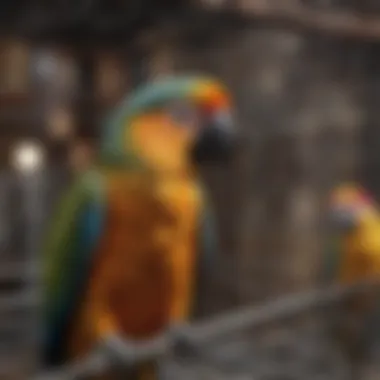
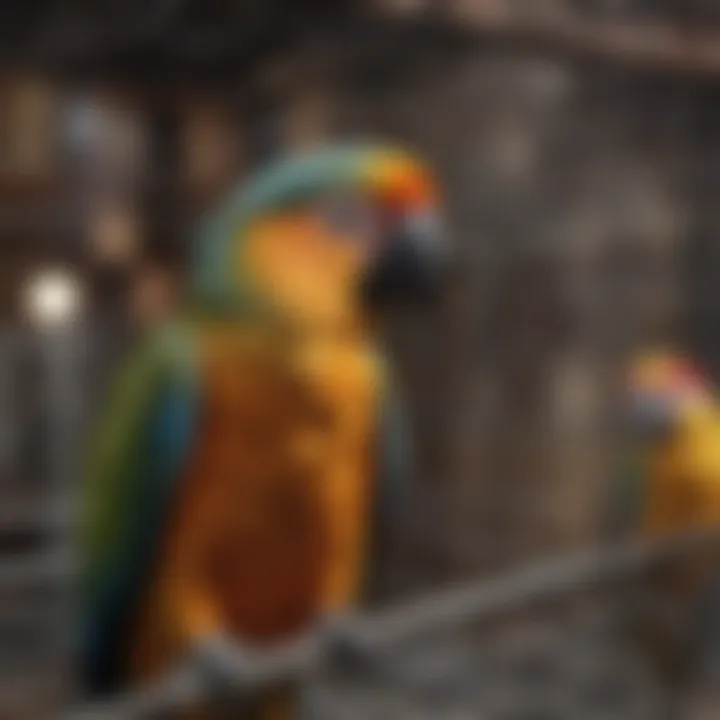
The dimensions of a parrot cage greatly influence the comfort and activity level of a bird. Larger cages allow for more space to move around, thus reducing stress. Birds need room to stretch their wings and engage in various activities, such as climbing and playing. It is important to consider the species of the bird as different types may require differing amounts of space.
A good rule of thumb is that the larger the parrot, the bigger the cage should be. Ideally, the cage should be at least two times the wingspan of your bird. This offers ample space for their natural behaviors.
Key Considerations for Dimensions:
- Height: Parrots enjoy climbing, so a tall cage gives them vertical space to explore.
- Width: Ensure there's plenty of room for perches and toys without overcrowding.
- Depth: Enough depth allows for comfortable movement and placement of feeding stations.
Materials and Durability
The choice of materials is critical in ensuring the safety and longevity of the parrot cage. Cages should be made from non-toxic materials that can withstand the wear and tear of everyday use. Stainless steel and powder-coated metal are often preferred due to their strength and ease of cleaning.
When evaluating cages, check the finish to ensure it is free of harmful substances. Some birds have a tendency to chew, so materials that are robust and cannot be easily damaged are essential in promoting lasting use.
Recommended Materials:
- Stainless Steel: Durable and easy to clean, reducing the risk of bacteria.
- Powder-Coated Metal: Provides a protective layer that resists rust and corrosion.
Bar Spacing and Design
The spacing of the bars in a parrot cage is another important feature. If the bars are too far apart, a parrot may escape or injure itself. Conversely, if they are too close, smaller birds might find it difficult to navigate their environment. A spacing of ½ inch to 1 inch is generally suitable for larger birds, while smaller species may require less.
Cage design should take into account aspects such as accessibility and visibility. A cage that allows easy access to feeding and cleaning areas will simplify maintenance. Additionally, the visibility of the cage can play a role in reducing stress. Birds thrive in environments where they feel secure and can observe their surroundings without constraints.
Design Considerations:
- Accessibility: Easy access to all areas of the cage promotes regular interaction.
- Visibility: Open designs can help birds feel less confined.
Properly understanding and selecting the essential features of large parrot cages leads to happier, healthier birds, thus enhancing the bond between pet and owner.
The Impact of Cage Size on Avian Behavior
The significance of cage size cannot be overstated in the realm of avian care. Large parrot cages directly influence the psychological and physical behaviors of these birds. A well-designed, spacious cage allows for a more fulfilling lifestyle for pet birds. Thus, understanding these impacts is vital for pet owners, breeders, and aspiring bird parents.
Social Interactions
Social interactions are fundamental to the well-being of parrots. In their natural habitats, these birds thrive in flocks. They engage in numerous social behaviors such as grooming, vocalizing, and playing. A larger cage facilitates these activities, allowing multiple birds to socialize effectively without overcrowding. It fosters a sense of security and helps establish a hierarchy within aviaries.
Birds kept in more confined spaces may exhibit signs of anxiety or aggressive behavior. They struggle with territorial issues when they feel cramped and vulnerable. In contrast, spacious cages can support collaborative activities, such as sharing toys or perching next to one another. This encouragement of positive social interactions contributes significantly to mental health.
Prominent researchers emphasize the importance of social structures in the lives of birds. Providing a larger environment can ease behavioral issues and lead to a more harmonious living situation. Thus, considering social aspects while selecting cage size is crucial.
Exploration and Play
Exploration and play are essential elements impacting a parrot's cognitive health. A spacious cage promotes an environment where birds can engage in natural exploratory behaviors. They can move freely, interact with various toys, and climb unimpeded. These activities sustain their curiosity and intelligence, key aspects for their mental stimulation.
When confined, parrots may show signs of boredom or frustration. A smaller cage limits movement and access to different activities, which can trigger destructive behavior. Instead, larger spaces encourage birds to use their instincts to explore new areas and engage with their surroundings.
To enhance play while ensuring safety, bird owners can incorporate different toys and structures in the cage. Parrots enjoy climbing, swinging, and hiding. Providing a rich environment allows them to express natural behaviors, thus improving their overall well-being.
Evaluating Cage Safety
Evaluating the safety of large parrot cages is a critical part of ensuring the well-being of pet birds. A safe cage minimizes risks of injury or poisoning, which can affect the health of birds. Owners must consider specific factors when assessing cage safety to create the best living environment.
Non-Toxic Materials
One of the primary concerns is the materials used in the construction of the cage. Birds often chew on various surfaces, making it essential to choose materials that are non-toxic. Common cage materials include stainless steel, powder-coated metals, and certain types of plastic. Each of these can vary in safety. For instance, stainless steel is ideal as it is durable and does not chip easily, reducing potential injury.
On the other hand, plastic components can sometimes contain harmful chemicals that may leach out. Therefore, verifying that any plastic parts are labeled as free from BPA and phthalates is crucial. Additionally, wood used in cages should be untreated and safe for birds. Materials that are deemed harmful, such as lead or zinc, should be avoided completely.
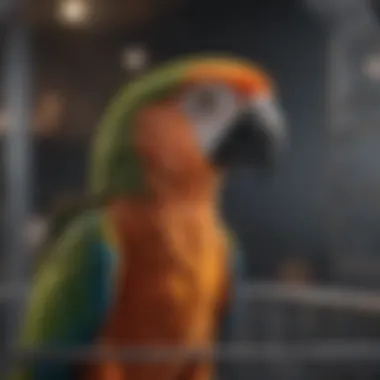
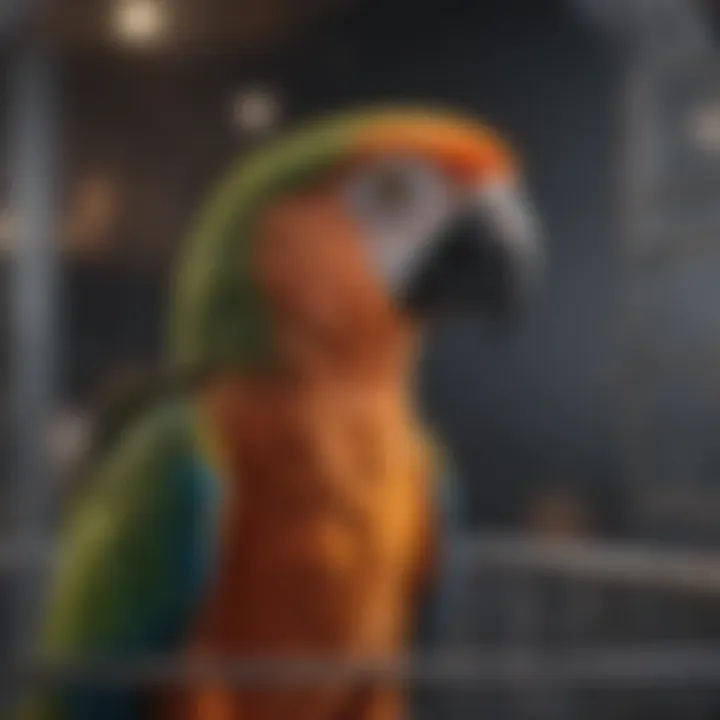
Secure Fastenings
The construction of the cage must include secure fastenings to prevent escapes and injuries. Weak or poorly designed locks can easily be manipulated by clever birds. It is important to inspect the locking mechanisms closely. Look for cages that feature locks that are birdsafe and cannot be opened accidentally.
Fastenings should also be resistant to wear and weather conditions, particularly if the cage is kept outside. Regularly checking these parts can prevent them from becoming loose over time. Using secure fastenings not only protects birds but also reassures owners about their pet’s safety.
Avoiding Dangerous Accessories
Cage accessories can enhance a bird's life, but they also pose safety risks if not chosen carefully. Accessories like swings, perches, and toys should be designed without small removable parts that can lead to choking hazards. Furthermore, avoid any items with sharp edges or toxic materials.
Items such as certain types of wood or metal can be dangerous if not verified as safe for avian contact. It's vital to select accessories explicitly marketed as safe for birds. This consideration extends to cleaning supplies as well—avoid any harsh chemicals. Opt for natural or bird-safe cleaners to maintain hygiene without exposing birds to harmful substances.
Ensuring the safety of your parrot’s cage involves selecting the right materials, securing fastenings, and choosing the right accessories.
In summary, evaluating cage safety involves detailed attention to various aspects, including the materials used, the integrity of fittings and locks, and the selection of safe accessories. These considerations are vital for creating a secure environment that enables birds to thrive.
Maintenance of Large Parrot Cages
Proper maintenance of large parrot cages is crucial for the health and happiness of your avian companions. Not only does it prolong the life of the cage itself, but it also ensures that the environment remains safe and hygienic for your birds. Regular maintenance involves cleaning and inspections, which contribute to preventing issues such as disease and discomfort. Therefore, establishing a consistent maintenance routine is essential for all parrot owners.
Regular Cleaning Routines
Cleaning a large parrot cage is fundamental in protecting the health of your birds. Parrots can be prone to bacterial infections and other illnesses if their environment is not kept clean. It is recommended to set a weekly cleaning schedule that includes the following steps:
- Remove accessories: Start by taking out all toys, perches, and feeders.
- Wash the cage: Use warm, soapy water and a non-toxic cleaner. Avoid harsh chemicals, as they can be harmful to birds. Rinse thoroughly to make sure no residue remains.
- Clean accessories: Submerge toys and dishes in a soapy solution. Disinfect them with a mixture of water and vinegar before rinsing.
- Inspect for feces: Pay attention to corners and hard-to-reach areas where droppings might accumulate. Make sure these areas are scrubbed well.
- Dry everything: Allow the cage and accessories to dry completely before placing them back into the cage. This prevents bacteria growth due to moisture.
Integrating these tasks into a regular cleaning schedule can significantly improve the cage's hygiene and the overall health of your birds.
Inspecting for Wear and Tear
Over time, cages can experience wear and tear that may lead to safety hazards for your pets. Regular inspections are necessary to catch issues early. Here are some points to consider during inspections:
- Check for rust or corrosion: Inspect metal components for signs of rust. If found, replace affected parts.
- Examine perches and toys: Ensure that perches and toys are in good condition. Replace any that are worn out or chipped to avoid injury.
- Assess the integrity of the bars: Look for bent or broken bars that might allow a bird to escape or get caught.
- Secure fastenings: Verify that all latches and locks function properly, as a secure cage is essential for your bird's safety.
Regularly inspecting the cage not only maintains a safe environment but also extends the lifespan of the cage itself. Keeping an eye on these details ensures a comfortable living space for your birds.
Factors to Consider When Choosing a Cage
Choosing the right cage for a parrot is vital for its overall well-being. Large parrot cages are not one-size-fits-all; various factors must be taken into account to ensure the bird is comfortable, safe, and stimulated. Understanding these considerations can help pet bird owners make informed decisions that directly impact the health and happiness of their feathered companions.
Species-Specific Requirements
Each parrot species has specific needs when it comes to their habitat. For example, larger parrot species like macaws require expansive space for movement and play. Smaller species, such as budgerigars, may adapt well to slightly smaller cages. It is crucial to measure the bird’s wingspan, activity level, and social behavior when selecting a cage.
- Space Needs: A cage should allow the bird to fully extend its wings without obstruction. Adequate height is also essential for climbing.
- Bar Spacing: Different species should have cages with bar spacing suited to their size. Smaller birds require closer spacing to prevent escape.
- Other Requirements: Consider the specific materials the bird prefers to chew on. For instance, conures often enjoy wooden perches and accessories, while some other species may favor different textures for enrichment.
Accurate species-specific adaptations lead not only to happiness but also to a sense of security within the environment.
Home Space Availability
Another significant factor is the space available in the owner’s home. Even the most well-designed cage can be detrimental if it cannot fit in the designated area. It’s important for owners to examine their living space and ensure that there is adequate room for the cage and safe movement around it.
Before purchasing a cage, take time to:
- Measure Space: Use a tape measure to gauge the area where the cage will go. Consider both width and height.
- Consider Access: Ensure that the cage can be positioned in a way that allows for easy access for cleaning and interaction with the bird.
- Environmental Considerations: Certain areas may have drafts or direct sunlight that can affect a parrot's comfort. Choose a location that maintains a stable environment.
"An appropriately sized cage not only satisfies the needs of the bird but also enhances the overall ambiance of the living space."
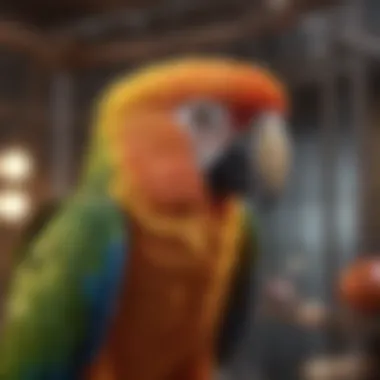
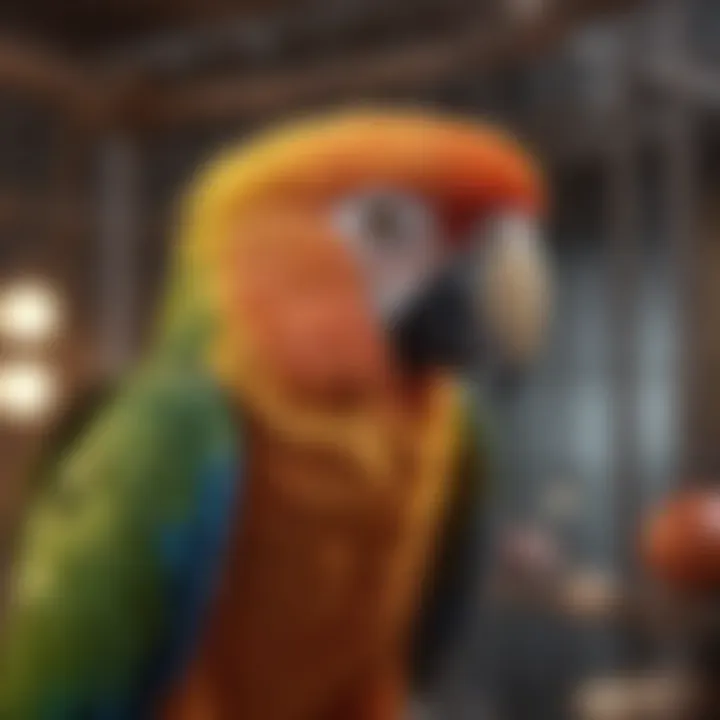
In summary, selecting a large parrot cage involves understanding species-specific requirements and assessing home space availability. Both factors are crucial in ensuring that the bird is not only comfortable but also thrives in its new home.
Budget Considerations for Large Parrot Cages
When selecting a large parrot cage, budgeting is a crucial factor that can significantly affect the well-being of your pet. Understanding how much you can allocate towards the cage will directly impact your choices regarding size, materials, and additional features. Properly investing in a large cage may seem like an upfront cost, but it often translates to long-term benefits for both the bird and the owner.
Cost vs. Quality
The relationship between cost and quality is often a delicate balance. More expensive cages usually offer better materials, increased durability, and safety features. Cheaper cages may lead to unwanted consequences like rapid wear and tear, which can endanger the bird.
- Material Quality: High-quality metals like stainless steel resist rust and corrosion, which is beneficial for longevity.
- Safety Features: cages with rounded edges and safe locking mechanisms are worth the extra expense, as they minimize escape risks and injury.
- Customization: More costly cages may provide options for custom configurations, helping in meeting specific bird needs and preferences.
An initial investment in a high-quality cage pays off over time. In contrast, cheaper options often require more frequent replacements.
Long-Term Investment
Investing in a large parrot cage should be viewed as a long-term commitment. Here are key considerations:
- Durability: A cage made from sturdy materials will withstand the wear and tear from daily use, thus not requiring replacement every few years.
- Bird Well-Being: A spacious and safe environment promotes mental and physical health. Investing correctly ensures your parrot can thrive.
- Potential Savings: Lower quality cages may necessitate purchases of additional accessories like liners and liners which can lead to higher costs over time.
- Resale Value: High-quality cages often retain better resale value, should you ever need to upgrade or change.
Overall, the choice of a cage must transcend mere cost. It should take into account quality, safety, and the long-term health of your feathered companion.
"Investing in a quality cage may cost more initially but ultimately proves beneficial for both bird and owner."
Keeping these budget considerations in mind guarantees that you will invest wisely, ensuring not only the immediate needs of your parrot but also their long-term happiness and health.
Accessories to Enhance Large Parrot Cages
Selecting the right accessories for large parrot cages is crucial for the overall environment and happiness of the birds. These accessories not only provide physical enrichment but also facilitate mental stimulation. Bird owners should carefully consider the types of accessories they introduce to their cages, as they can significantly impact the daily lives of their feathered companions.
Perches and Toys
Perches are essential for any parrot cage. They provide resting spots and allow birds to exercise their feet. The type of perch can vary, including natural wood perches and constructed perches made from various materials. Natural wood perches, like those made from branches, are often preferred because they mimic the natural habitat and offer varying diameters, which is beneficial for foot health. In contrast, manufactured perches might offer a smoother surface that can be easier to clean but may not provide the same benefits for foot grip.
Toys are equally important for mental stimulation. Parrots are intelligent creatures who require interaction and engagement. Toys should vary in texture, shape, and material. Some toys encourage problem-solving, while others promote chewing and shredding behavior. For instance, toys made of cardboard, wood, and rope provide different sensory experiences. When choosing toys, it’s essential to consider the size and strength of the parrot. Larger birds like macaws require durable, robust toys that can withstand strong beaks.
Providing a variety of perches and toys can help reduce boredom and behavioral issues in parrots.
Food and Water Bowls
Food and water bowls are fundamental accessories that should not be overlooked. They must be appropriately sized to accommodate the bird species. For large parrots, sturdy bowls made from stainless steel or ceramic are preferred, as they prevent hoarding or spillage. Additionally, positioning the bowls correctly within the cage can ensure that birds can easily access food and water, which is vital for their health.
Moreover, incorporating several feeding stations can mimic foraging behavior, allowing birds to search for food, much like they would in the wild. This not only encourages natural behaviors but also promotes physical activity. It is essential to clean these bowls regularly to prevent the growth of bacteria and ensure that the birds have access to fresh food and clean water.
In summary, well-thought-out accessories such as perches, toys, food, and water bowls enhance the living conditions for large parrots. By focusing on the types and arrangements of these items, bird owners can create an enriching environment that caters to the needs of their avian companions.
Epilogue: The Case for Large Parrot Cages
Large parrot cages are not merely structures for housing birds; they are essential components of any pet bird owner's home. This conclusion synthesizes the rich information contained in this comprehensive guide, emphasizing the importance of such cages in fostering healthy, happy environments for our avian companions.
Summary of Key Points
Several critical elements underscore the significance of large parrot cages:
- Enhanced Welfare: Larger cages allow for greater movement and exploration, which are vital to the well-being of parrots. Ample space contributes to reduced stress and encourages natural behaviors.
- Behavioral Impact: The size and design of the cage directly affect how birds socialize and interact. Birds housed in larger environments often exhibit more exploratory behavior, contributing to better mental health.
- Health Considerations: Physical health benefits arise from having enough room to exercise. A large cage can promote better muscle tone and cardiovascular fitness through play and movement.
- Safety and Maintenance: Choosing cages made from safe materials and those designed with structural integrity leads to a safer environment for birds. Regular maintenance further prevents hazards.
These points blend together to paint a picture of why investing in large cages is a practical and compassionate decision for bird owners.
Final Recommendations
To support the well-being of your feathered friends, consider the following recommendations:
- Invest in Size: Choose cages that fit the specific needs of your parrot species, ensuring they have enough room to stretch their wings and perch comfortably.
- Prioritize Quality: Select a cage made from non-toxic, durable materials. Stay away from those with sharp edges or that can easily rust.
- Incorporate Accessories: Include various perches, toys, and enrichment items to create a stimulating environment within the cage. Varied textures and heights improve the quality of life.
- Regularly Assess Needs: Monitor your parrot’s behavior and health. Be open to upgrading the cage size if necessary, especially as they grow or if you get additional birds.
- Safety Above All: Ensure all components of the cage are secure. Inspect for wear and tear regularly and replace any damaged accessories promptly.
Ultimately, a large parrot cage is a significant investment in the happiness and health of your pet. It creates a thriving habitat conducive to natural behaviors while ensuring safety and promoting engagement.















